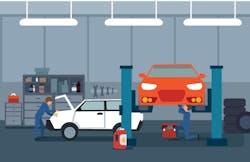We’re continuing on with our quest to develop a robust and detailed standard operating procedure for blueprinting. Because, if you don’t have a thorough SOP, your body shop will struggle to overcome preventable roadblocks in your workflow.
I’ve found that most interruptions to flow are preventable, but shops (even sometimes my own shops) still experience self-inflicted delays, often near the end of a repair. With that in mind, I want to share a few additional ideas on how to bolster your blueprinting SOP.
Stop me if you’ve experienced this scenario before: You’re near the end of a repair, post-repair scans are done, and all that remains is a final road test and final clean up. But, during the road test you notice the car is pulling a bit. So, you take the car to have the alignment checked and, lo and behold, the alignment specs are out of tolerance because a tie rod and the strut are slightly bent.
In this scenario, you’re likely a bit panicked because the customer is expecting the car today and there’s no way you’ll be able to get the parts you need in time to install them and do the alignment and detail the car.
Shoot! Nobody likes making that call to the customer.
Most of us have had this sort of surprise occur before but it’s almost completely preventable. If you take time to assess the situation and do some root cause analysis you’ll be able to backtrack to your blueprinting process and discover that a small addition to your SOP will do wonders for preventing such unwanted surprises.
When we’ve had situations like this occur at my shops we learned they usually happened when there was minor cosmetic damage to a road wheel, or there was some sort of impact to a tire. We couldn’t see any damage to the suspension, but the alignment machine (at the end of the repair) always picked up that the camber, caster or toe was out of spec and not adjustable because parts were bent and needed replacement. Our analysis also showed that if a wheel was damaged enough to require replacement, we would put the alignment operation on our repair plan but wouldn’t perform the alignment until the end of the repair sequence, and we were still getting surprises. The same situation would sometimes occur when just a tire was damaged and needed replacement.
Finally, our analysis showed that we often encountered additional damaged suspension components after we replaced the parts that were obviously and visually damaged.
So, what’s the next logical step after the root cause analysis was completed? If you subscribe to the idea that the blueprint process should be designed to discover and describe all damage, then it seems logical to include possible suspension damage in your discovery process. Once you have a good collection of data on what types of conditions can cause suspension damage, you can use these conditions as a trigger point for conducting more thorough suspension diagnosis at the time of blueprinting. For example, you could put in a rule that says “if there was contact to a wheel and or tire at the time of the collision, we must put the vehicle on an alignment machine and do an alignment check with a printout of the specifications.”
Damage to suspension components can be tricky to recognize. Such rules could be implemented in order to know the extent of any possible suspension damage or misalignment. Rules like that are the only way to eliminate a lot of grief caused by last-minute suspension issues. Plus, you’ll have documentation to present to the customer or third party payer that clearly validates the condition of the suspension components and alignment specifications prior to beginning the actual repairs.
An alignment check can reveal suspension crossmembers and engine cradles that are bent or out of position. An alignment check can also detect steering axis inclination issues that may point to a strut tower that is out of position.
One primary purpose of blueprinting is to create predictable outcomes on every single repair. The elimination of supplements, delays and surprises is the way to get the predictable outcomes. Adding an alignment check when warranted should be a key addition to your blueprinting process.
Next month I’ll suggest a few other tips and tricks for you to consider in your blueprinting SOP and move in to systems and procedures for measuring the productivity, efficiency and profitability of your SOP.
About the Author

Steve Morris
The late Steve Morris was the regional director for Classic Collision in California (formerly Pride Collision Centers). He was an Accredited Automotive Manager (AAM) and ASE-certified master technician. Morris died April 22, 2022, at the age of 63 of complications following surgery.
